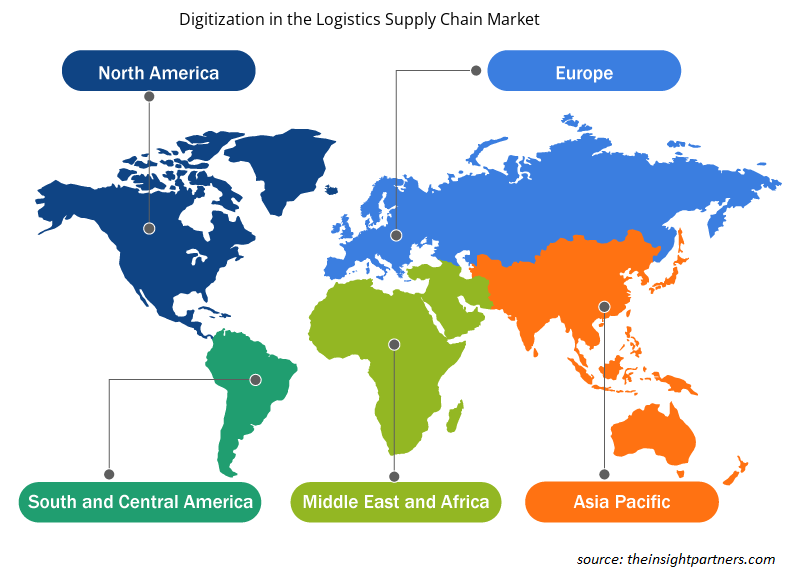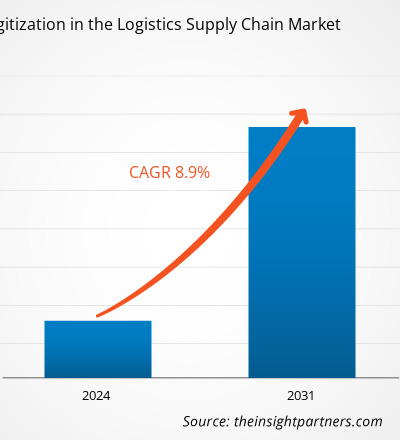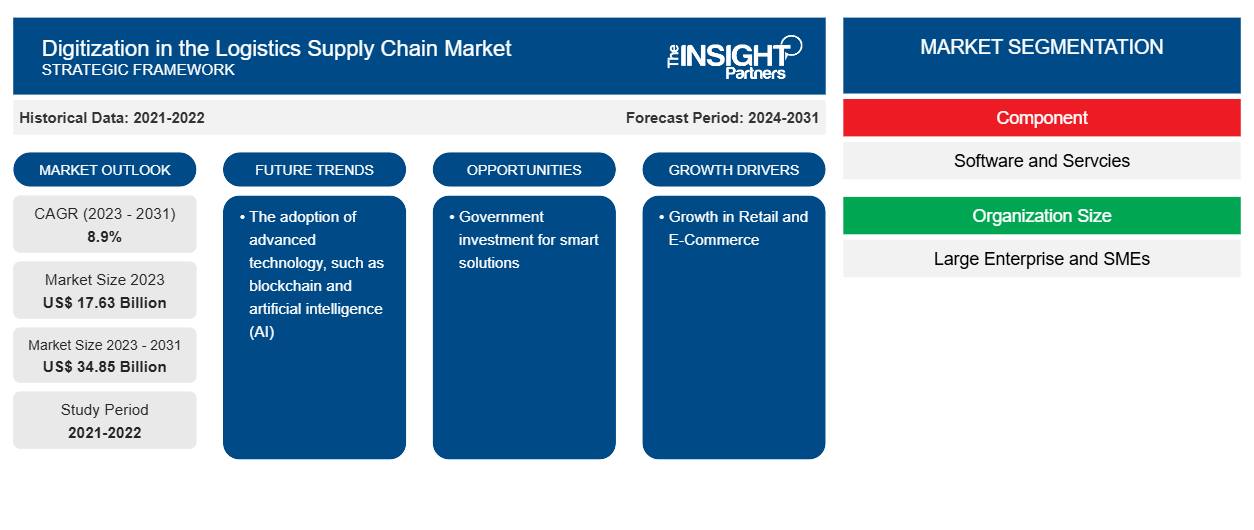من المتوقع أن يصل حجم التحول الرقمي في سوق سلسلة التوريد اللوجستية إلى 34.85 مليار دولار أمريكي بحلول عام 2031 من 17.63 مليار دولار أمريكي في عام 2023. ومن المتوقع أن يسجل السوق معدل نمو سنوي مركب بنسبة 8.9٪ في الفترة 2023-2031. ومن المرجح أن يظل الطلب المتزايد على إدارة سلسلة التوريد وزيادة صناعة التجزئة والتجارة الإلكترونية من العوامل الرئيسية للتحول الرقمي في اتجاهات سوق سلسلة التوريد اللوجستية.
تحليل سوق التحول الرقمي في سلسلة التوريد اللوجستية
لقد استفاد مشغلو هذه الصناعات على نطاق واسع من الأتمتة في مختلف الصناعات مثل صناعة السيارات وتجارة التجزئة والتجارة الإلكترونية والتصنيع والرعاية الصحية وغيرها من خلال تقليل الأخطاء البشرية. على سبيل المثال، ينمو قطاع التجزئة في جميع أنحاء العالم باستمرار ومن المتوقع أن ينمو أكثر في المستقبل. وبالتالي، تركز صناعة التجزئة المتنامية على خفض إجمالي تكاليف التشغيل من خلال إزالة العمليات اليدوية لتخزين وإدارة سلسلة التوريد والخدمات اللوجستية. الطلب على حلول الأتمتة في جميع أنحاء صناعة التجزئة يغذي السوق. يشهد قطاع الخدمات اللوجستية في العديد من الصناعات تحولًا رقميًا حيث يميل أصحاب المصلحة نحو تقليل الأخطاء وتحسين العمليات والتسليم في الوقت المحدد، مما يدفع السوق.
نظرة عامة على التحول الرقمي في سوق سلسلة التوريد اللوجستية
يؤدي التقدم في التحول الرقمي إلى تغيير نماذج الأعمال التقليدية لتصبح أكثر فعالية وكفاءة. يساعد تبني التقنيات الرقمية اللاعبين في السوق عبر العديد من الصناعات على اكتساب ميزة تنافسية على اللاعبين الآخرين من خلال تحسين نماذج أعمالهم. تساعد رقمنة عمليات سلسلة التوريد اللوجستية في توفير التكاليف على القوى العاملة وتسريع عملياتهم وتقليل الأخطاء. يساعد إدراج التقنيات الأكثر تقدمًا، مثل الذكاء الاصطناعي (AI)، في اتخاذ قرارات عمل فعالة باستخدام التحليلات المتقدمة.
قم بتخصيص هذا التقرير ليناسب متطلباتك
ستحصل على تخصيص لأي تقرير - مجانًا - بما في ذلك أجزاء من هذا التقرير، أو تحليل على مستوى الدولة، وحزمة بيانات Excel، بالإضافة إلى الاستفادة من العروض والخصومات الرائعة للشركات الناشئة والجامعات
-
احصل على أهم اتجاهات السوق الرئيسية لهذا التقرير.ستتضمن هذه العينة المجانية تحليلاً للبيانات، بدءًا من اتجاهات السوق وحتى التقديرات والتوقعات.
التحول الرقمي في سوق سلسلة التوريد اللوجستية: العوامل المحفزة والفرص
النمو في تجارة التجزئة والتجارة الإلكترونية لصالح السوق
كان ارتفاع الدخل والقدرة الشرائية للأفراد عاملاً رئيسيًا أدى إلى النمو في صناعة التجزئة والتجارة الإلكترونية. وقد أدى ارتفاع انتشار الهاتف المحمول واتصالات الإنترنت إلى توفير الجدوى وسهولة الوصول إلى صناعة التجزئة، مما أدى إلى نمو صناعة التجارة الإلكترونية. وفقًا لمؤسسة India Brand Equity Foundation (IBEF)، فإن دولًا مثل الولايات المتحدة وكندا وألمانيا والمملكة المتحدة والصين واليابان وفرنسا وأستراليا وسويسرا وإيطاليا والهند من بين دول أخرى تتمتع بسوق تجزئة قوية. تساعد الرقمنة في سلسلة توريد الخدمات اللوجستية أصحاب المصلحة في سلسلة التوريد على تحسين عملياتهم. تساعد الرقمنة في تتبع وتتبع الطلبات والمواد الخام في سلسلة التوريد في الوقت الفعلي. كما تساعد في التنسيق الفعال بين الشركات المصنعة والموردين والموزعين وتجار التجزئة لتقليل التكاليف وزيادة الجودة وتلبية متطلبات العملاء. وبالتالي، فإن النمو في تجارة التجزئة والتجارة الإلكترونية يدفع الطلب على الحلول لتعزيز سلسلة التوريد وسير العمل اللوجستي مما يدفع بشكل أكبر الرقمنة في نمو سوق سلسلة توريد الخدمات اللوجستية.
الاستثمار الحكومي في الحلول الذكية – فرصة في التحول الرقمي في سوق سلسلة التوريد اللوجستية
لتعزيز التحول الرقمي في جميع أنحاء العالم، تستثمر الحكومة في الحلول الذكية. يساعد توفير الحلول الذكية في تعزيز الإنتاج وتحسين العمليات وتوفير عائد أعلى على الاستثمار. كما يساعد في تبسيط نماذج الأعمال المعقدة وتعزيز العمليات بشكل أسرع.
- في سبتمبر 2023، أعلنت إدارة بايدن-هاريس عن تخصيص 160 مليون دولار أمريكي لتكنولوجيا النقل الذكية. وركز هذا الاستثمار أيضًا على ابتكار الأنظمة، مثل التوصيل والخدمات اللوجستية وإشارات المرور والشبكة الذكية وتكامل البيانات.
- في فبراير 2023، أعلن وزير المالية الهندي عن تخصيص ميزانية تقدر بنحو 3363.5 مليون دولار أمريكي (27482 كرور روبية هندية) لشركة ممر الشحن المخصص للهند (DFCC)، بزيادة قدرها 75٪ مقارنة بالعام السابق. وسلط خطاب الميزانية الضوء على إعطاء الأولوية لـ 100 مشروع أساسي للبنية التحتية للنقل، مثل التسليم في الميل الأخير والأول للموانئ والفحم والصلب والأسمدة والحبوب الغذائية.
وبالتالي، فإن مثل هذه الاستثمارات يمكن أن تعزز التحول الرقمي في قطاع الخدمات اللوجستية وسلسلة التوريد وتكون بمثابة فرصة لنمو السوق.
تقرير تحليل التجزئة لسوق التحول الرقمي في سلسلة التوريد اللوجستية
إن القطاعات الرئيسية التي ساهمت في اشتقاق الرقمنة في تحليل سوق سلسلة التوريد اللوجستية هي المكونات وحجم المنظمة والصناعة.
- بناءً على المكونات، ينقسم السوق إلى البرمجيات والخدمات. احتل قطاع البرمجيات حصة سوقية أكبر في عام 2023.
- بحسب حجم المنظمة، يتم تقسيم السوق إلى شركات كبيرة وصغيرة الحجم. استحوذت شريحة الشركات الكبيرة على أكبر حصة من السوق في عام 2023.
- بحسب الصناعة، يتم تقسيم السوق إلى تجارة التجزئة والتجارة الإلكترونية والرعاية الصحية والتصنيع والسيارات وغيرها. احتل قطاع تجارة التجزئة والتجارة الإلكترونية الحصة الأكبر من السوق في عام 2023.
تحليل حصة سوق التحول الرقمي في سلسلة التوريد اللوجستية حسب المنطقة الجغرافية
ينقسم النطاق الجغرافي للتحول الرقمي في تقرير سوق سلسلة التوريد اللوجستية بشكل أساسي إلى خمس مناطق: أمريكا الشمالية، ومنطقة آسيا والمحيط الهادئ، وأوروبا، والشرق الأوسط وأفريقيا، وأمريكا الجنوبية/أمريكا الجنوبية والوسطى.
من حيث الإيرادات، استحوذت أمريكا الشمالية على أكبر حصة في التحول الرقمي في سوق سلسلة توريد الخدمات اللوجستية. تعد الولايات المتحدة وكندا والمكسيك من بين الدول الرئيسية في أمريكا الشمالية. تعد المنطقة من أوائل الدول التي تبنت الحلول المتقدمة تقنيًا، وهو أحد العوامل الرئيسية التي تدفع نمو السوق. يؤدي ارتفاع صناعة التجزئة والتجارة الإلكترونية في المنطقة إلى توليد الطلب على الحلول الرقمية لتحسين أنشطة سلسلة التوريد والخدمات اللوجستية، مما يعزز السوق. وفقًا لوزارة التجارة الأمريكية، ارتفعت مبيعات التجزئة والخدمات الغذائية في الولايات المتحدة بنسبة 0.6٪ في فبراير 2024 مقارنة بشهر يناير 2024. بالإضافة إلى ذلك، وفقًا لإدارة التجارة الدولية، كان لدى كندا حوالي 75٪ من مستخدمي التجارة الإلكترونية من إجمالي سكان كندا في عام 2022 ومن المتوقع أن يرتفع إلى 77.6٪ بحلول عام 2025. يتزايد عدد الأشخاص في كندا الذين يشترون الأشياء عبر الإنترنت، مما يساهم في زيادة أنشطة التجارة الإلكترونية في البلاد مثل عمليات توصيل المنتجات.
التحول الرقمي في سوق سلسلة التوريد اللوجستية: رؤى إقليمية
لقد قام المحللون في Insight Partners بشرح الاتجاهات والعوامل الإقليمية المؤثرة على التحول الرقمي في سوق سلسلة التوريد اللوجستية طوال فترة التوقعات بشكل شامل. يناقش هذا القسم أيضًا التحول الرقمي في قطاعات سوق سلسلة التوريد اللوجستية والجغرافيا عبر أمريكا الشمالية وأوروبا ومنطقة آسيا والمحيط الهادئ والشرق الأوسط وأفريقيا وأمريكا الجنوبية والوسطى.

- احصل على البيانات الإقليمية المحددة للتحول الرقمي في سوق سلسلة التوريد اللوجستية
نطاق تقرير التحول الرقمي في سوق سلسلة التوريد اللوجستية
| سمة التقرير | تفاصيل |
|---|---|
| حجم السوق في عام 2023 | 17.63 مليار دولار أمريكي |
| حجم السوق بحلول عام 2031 | 34.85 مليار دولار أمريكي |
| معدل النمو السنوي المركب العالمي (2023 - 2031) | 8.9% |
| البيانات التاريخية | 2021-2022 |
| فترة التنبؤ | 2024-2031 |
| القطاعات المغطاة |
حسب المكون
|
| المناطق والدول المغطاة |
أمريكا الشمالية
|
| قادة السوق وملفات تعريف الشركات الرئيسية |
|
كثافة اللاعبين في سوق سلسلة التوريد اللوجستية: فهم تأثيرها على ديناميكيات الأعمال
يشهد سوق التحول الرقمي في سلسلة توريد الخدمات اللوجستية نموًا سريعًا، مدفوعًا بالطلب المتزايد من المستخدم النهائي بسبب عوامل مثل تفضيلات المستهلكين المتطورة والتقدم التكنولوجي والوعي المتزايد بفوائد المنتج. ومع ارتفاع الطلب، تعمل الشركات على توسيع عروضها والابتكار لتلبية احتياجات المستهلكين والاستفادة من الاتجاهات الناشئة، مما يؤدي إلى زيادة نمو السوق.
تشير كثافة اللاعبين في السوق إلى توزيع الشركات أو المؤسسات العاملة في سوق أو صناعة معينة. وهي تشير إلى عدد المنافسين (اللاعبين في السوق) الموجودين في مساحة سوق معينة نسبة إلى حجمها أو قيمتها السوقية الإجمالية.
الشركات الرئيسية العاملة في مجال التحول الرقمي في سوق سلسلة التوريد اللوجستية هي:
- ساب اس اي
- شركة أوراكل
- آي بي إم
- شركة إنتل
- معلومات
- شركة هيكساوير للتكنولوجيا المحدودة
إخلاء المسؤولية : الشركات المذكورة أعلاه ليست مرتبة بأي ترتيب معين.

- احصل على نظرة عامة على أهم اللاعبين الرئيسيين في مجال التحول الرقمي في سوق سلسلة التوريد اللوجستية
التحول الرقمي في سوق سلسلة التوريد اللوجستية: الأخبار والتطورات الأخيرة
يتم تقييم التحول الرقمي في سوق سلسلة التوريد اللوجستية من خلال جمع البيانات النوعية والكمية بعد البحث الأولي والثانوي، والتي تتضمن منشورات الشركات المهمة وبيانات الجمعيات وقواعد البيانات. فيما يلي قائمة بالتطورات في السوق:
- في ديسمبر 2023، أعلنت شركة فوجيتسو عن إطلاق خدمة جديدة لتوحيد معايير البيانات اللوجستية وتصورها عبر السحابة للشاحنين وشركات الخدمات اللوجستية والبائعين عبر سلسلة التوريد. تقدم الخدمة أدوات جديدة للعملاء لتحقيق الاستدامة في عملياتهم ومعالجة مجموعة متنوعة من التحديات، بما في ذلك النقص الوشيك في سائقي الشاحنات، والحاجة الملحة للحد من البصمة الكربونية للنقل، والامتثال للوائح الصناعية الأكثر صرامة. (المصدر: فوجيتسو، بيان صحفي، 2023)
- في يناير 2024، أعلنت شركة Blue Yonder، وهي شركة رائدة في توفير حلول سلسلة التوريد، عن إصدار أكبر تحديث للمنتج في تاريخ الشركة، حيث أطلقت أول مجموعة من الحلول المتوافقة عبر سلسلة التوريد بأكملها - من التخطيط إلى المستودعات والنقل والتجارة - والتي يتم تقديمها على منصة Luminate Cognitive الخاصة بالشركة. يتيح الاعتماد على قابلية التشغيل البيني لشركة Blue Yonder تزويد عملائها بزيادة الإنتاجية وتقليل النفايات وسلاسل التوريد الأكثر مرونة. (المصدر: Blue Yonder، بيان صحفي، 2024)
تغطية تقرير سوق التحول الرقمي في سلسلة التوريد اللوجستي والمنتجات النهائية
يقدم تقرير "حجم سوق التحول الرقمي في سلسلة التوريد اللوجستية والتوقعات (2021-2031)" تحليلاً مفصلاً للسوق يغطي المجالات التالية:
- حجم السوق والتوقعات على المستويات العالمية والإقليمية والوطنية لجميع قطاعات السوق الرئيسية التي يغطيها النطاق
- ديناميكيات السوق مثل المحركات والقيود والفرص الرئيسية
- الاتجاهات المستقبلية الرئيسية
- تحليل مفصل لقوى PEST/Porter الخمس وSWOT
- تحليل السوق العالمي والإقليمي الذي يغطي اتجاهات السوق الرئيسية واللاعبين الرئيسيين واللوائح والتطورات الأخيرة في السوق
- تحليل المشهد الصناعي والمنافسة الذي يغطي تركيز السوق، وتحليل خريطة الحرارة، واللاعبين البارزين، والتطورات الأخيرة
- ملفات تعريف الشركة التفصيلية
- التحليل التاريخي (سنتان)، سنة الأساس، التوقعات (7 سنوات) مع معدل النمو السنوي المركب
- تحليل PEST و SWOT
- حجم السوق والقيمة / الحجم - عالمي، إقليمي، بلد
- الصناعة والمنافسة
- مجموعة بيانات إكسل
التقارير الحديثة
تقارير ذات صلة
شهادات العملاء
سبب الشراء
- اتخاذ قرارات مدروسة
- فهم ديناميكيات السوق
- تحليل المنافسة
- رؤى العملاء
- توقعات السوق
- تخفيف المخاطر
- التخطيط الاستراتيجي
- مبررات الاستثمار
- تحديد الأسواق الناشئة
- تحسين استراتيجيات التسويق
- تعزيز الكفاءة التشغيلية
- مواكبة التوجهات التنظيمية























 احصل على عينة مجانية ل - التحول الرقمي في سوق سلسلة التوريد اللوجستية
احصل على عينة مجانية ل - التحول الرقمي في سوق سلسلة التوريد اللوجستية